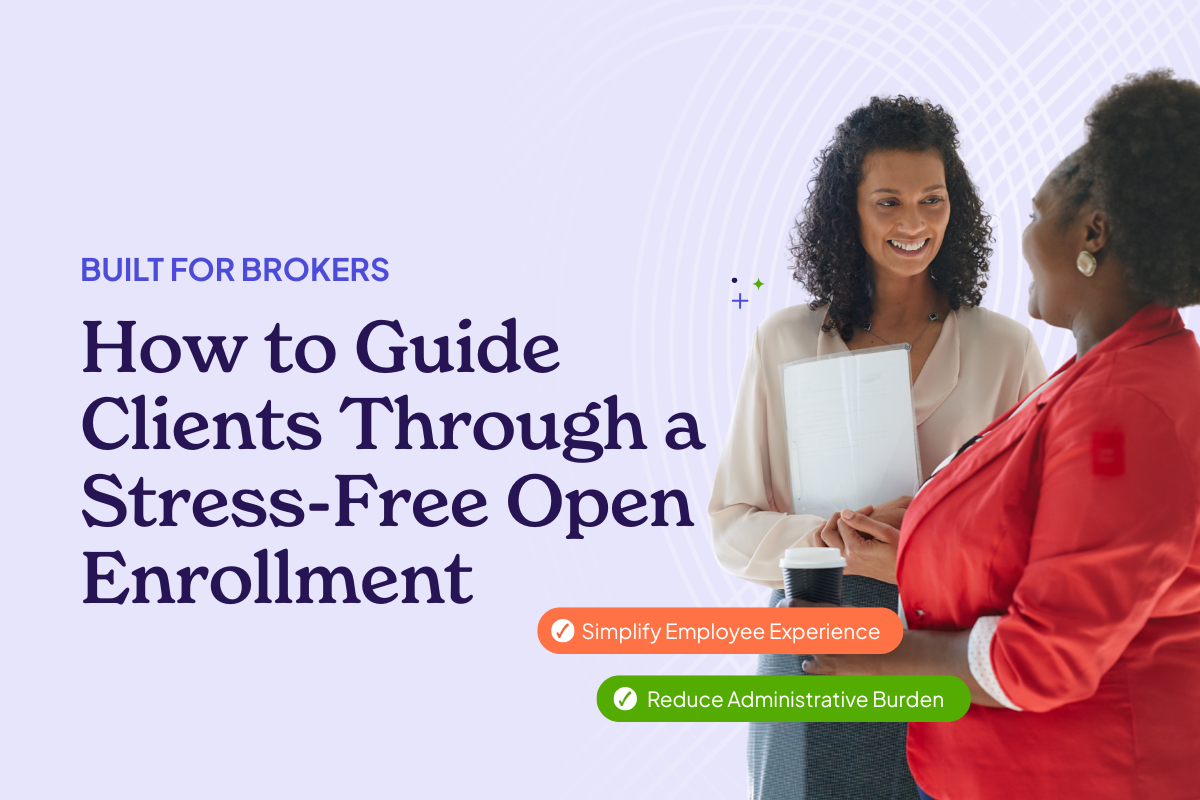How to Guide Clients Through Stress-Free Open Enrollment

Open Enrollment Without the Headaches
Open enrollment season often gets compared to tax season or finals week—a mix of high stakes, tight deadlines, and lots of stress. For HR teams, the pressure is real: juggling compliance requirements, fielding nonstop employee questions, and making sure every box is checked on time.
This is where brokers can shine. You’re not just there to recommend plans—you’re the guide helping clients plan the route, avoid turbulence, and land OE successfully. The good news? With the right approach, open enrollment doesn’t have to be a fire drill.
Here are three practical ways you can help clients simplify open enrollment and reduce stress for everyone involved.
1. Start Early and Set Expectations
Too many HR teams treat open enrollment prep like cramming for an exam—waiting until October to start studying. As a broker, you can shift that mindset.
What to do:
- Build a timeline: Encourage clients to start planning OE 3–6 months in advance, with milestones for plan design decisions, employee communications, and technology setup. Check out our Full Open Enrollment Guide to help clients build an Open Enrollment timeline.
- Share checklists: Provide a compliance and logistics checklist covering ACA reporting, COBRA notifications, and 1095-C forms so nothing falls through the cracks. Clients can refer to this checklist that walks through benefits compliance strategies.
- Create a communication calendar: Suggest launching employee communication at least 30 days before enrollment begins to minimize confusion and last-minute questions. This template gives ready-to-use emails for HR teams to get started and stay ahead of OE communications.
Why it matters: Early prep means fewer mistakes, less scrambling, and a smoother experience for employees.
Broker takeaway: Frame yourself as the project manager who ensures no one is caught off guard.
Planning OE late is like realizing Thanksgiving morning you forgot to buy the turkey—by then, it’s too late.
2. Simplify the Employee Experience
If employees are confused, HR feels the ripple effect. Endless calls and emails from employees asking “Which plan should I choose?” or “What’s a deductible again?” can quickly overwhelm HR teams.
What to do:
- Recommend decision-support tools: Look for platforms that use guided enrollment or interactive tools that help employees compare plans side by side.
- Keep it simple: Provide templates with plain-language benefits explanations, avoiding jargon like “co-insurance” without examples.
- Promote mobile-friendly access: Employees expect to enroll anytime, anywhere. A mobile enrollment option reduces friction and increases participation rates. Here’s some tips for managing open enrollment for a deskless workforce.
- Encourage year-round education: Suggest that clients send out bite-sized reminders throughout the year, not just at OE, to keep benefits top of mind.
Why it matters: A clear, user-friendly OE experience boosts employee confidence, reduces HR workload, and improves overall benefits satisfaction.
Broker takeaway: You’re not just solving for HR—you’re helping them win credibility with their employees.
It’s the difference between handing employees a GPS with step-by-step directions versus a paper map with no landmarks.
3. Leverage Technology to Reduce Admin Burden
Manual OE is a recipe for errors, stress, and inefficiency. Spreadsheets, email reminders, and paper forms leave HR juggling tasks that tech could automate.
What to do:
- Automate the basics: Recommend platforms that send enrollment reminders, track eligibility, and flag missing information automatically (like Selerix Engage).
- Integrate systems: Ensure benefits platforms connect with payroll, HRIS, and carriers to reduce duplicate data entry.
- Provide reporting tools: Encourage clients to use real-time reporting to track enrollment progress and spot issues before deadlines.
- Focus on compliance safeguards: Tech should support HIPAA and ACA requirements while protecting sensitive employee data.
- Why it matters: Technology reduces the administrative burden on HR, minimizes compliance risk, and frees up bandwidth for more strategic work.
Broker takeaway: By connecting clients to the right platform, you transform OE from a manual grind into a streamlined process.
Instead of carrying groceries in one bag at a time, you’re handing HR a cart with wheels.
Why Stress-Free OE Matters
When open enrollment runs smoothly:
- HR avoids costly compliance errors.
- Employees feel more confident in their benefits decisions.
- Clients associate OE success with your expertise and guidance.
In short, stress-free OE doesn’t just protect your clients—it strengthens your value as a trusted advisor.
How Selerix Helps Brokers Deliver Stress-Free OE
At Selerix, we know that no two clients are alike. That’s why our platform is designed to adapt:
- Configurable solutions for mid-market companies, and large enterprises.
- Built-in tools for employee engagement, decision support, and streamlined enrollment.
- Seamless integrations with carriers, payroll, and HR systems.
- Year-round support that helps clients prepare for OE well before deadlines hit.
With Selerix, you don’t just recommend a platform—you deliver a solution that reduces stress, improves accuracy, and links a partner that can play a crucial role in enhancing the employee experience.
Schedule a demo to learn more.


